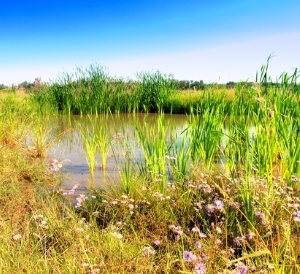Revised Definition Waters of the United States Clean Air Act Law Review
Past Mr. Ken Bogdan and Mr. Al Herson

Under Clean Water Act (CWA) Section 404, the U.s.a. Ground forces Corps of Engineers (USACE) must upshot a permit for discharges of dredged or fill fabric into "waters the United States" (WOTUS). On June 29, 2015, the Environmental Protection Bureau (EPA) and USACE published its last rule defining "waters of the Us" for purposes of Section 404 and other sections of the CWA. The highly controversial regulations were summarized in the Baronial Edition of California Environmental Law Reporter, and became effective on August 28, 2015. This article reviews the regulations' historical groundwork, contents, likely regulatory effects, and potential legal challenges. This article appears in the Oct. 2015 issue of California Ecology Law Reporter.
Excerpt:
Department 404 of the Clean Water Human activity and Waters of the The states. The Make clean Water Act authorizes EPA to regulate water quality through the restriction of pollution discharges. The authorization of EPA under the Clean Water Human action to regulate all "pollution activities" affecting the waters of the U.s.a. is modified by Section 404 where the Corps retains the principal responsibleness to regulate discharges of dredged or make full fabric into waters of the United States. Under the Clean Water Act, nevertheless, EPA has a specific oversight role over the USACE's authority.
The Clean Water Deed'southward term "waters of the U.s." was expansively divers in EPA's and the Corps' previous regulations to include all waters currently used, used in the by, or susceptible to apply in interstate or foreign commerce, or that "could bear upon" interstate or strange commerce. In general, federal regulatory authority over the states and individual belongings is derived from the interstate commerce clause of the U.S. Constitution. In addition to traditional navigable waters, "waters of the U.s." was divers to include all "other waters," such equally intrastate lakes, rivers, streams (including intermittent streams), mudflats, sand flats, wetlands, sloughs, prairie potholes, wet meadows, playa lakes, natural ponds, and wetlands adjacent to any waters of the United states (other than waters that are themselves wetlands) the use, degradation, or devastation of which could affect interstate or foreign commerce. The final rule makes major changes to these controversial elements of the waters of the United States definition.
SWANCC and Rapanos. The final rule attempts to address the challenges associated with interpreting the previous regulatory definition besides as resolve years of legal controversy well-nigh the definition of certain waters, including wetlands, subject area to CWA regulation. In 2001, the United States Supreme Courtroom set up off a round of controversy and dubiousness about the waters and wetlands regulated by the Section 404 program in its landmark SWANCC ruling. Farther confusion about the definition of jurisdictional waters and wetlands was created by the Supreme Courtroom'due south Rapanos decision in 2006.
In SWANCC the Supreme Courtroom held that the USACE's jurisdiction nether the CWA does non extend to intrastate, isolated waters and wetlands where the sole basis for interstate commerce connection was through the wetlands use every bit habitat for migratory birds. The SWANCC decision created swell uncertainty well-nigh which nonnavigable wetlands and waters continued to be subject to Section 404 jurisdiction.
In the consolidated cases, Rapanos v. United States and Carabell v. United States (jointly referred to as Rapanos), the Supreme Courtroom considered whether the waters of the Usa extend to wetlands that are not adjacent to, or fifty-fifty shut to, waters that are navigable in fact. The Supreme Court issued five dissever opinions with no single majority opinion, thus creating considerable confusion in how to use the example. Justice Kennedy's concurring opinion to Justice Scalia's more conservative plurality opinion was generally the most influential in subsequent court decisions and regulatory practise. His plurality opinion held that CWA jurisdiction applies to traditional navigable waters (e.g., rivers and lakes) and all other waters (including intermittent waters) with a "significant nexus" to a traditional navigable water. Many commentators criticized the "significant nexus" test as requiring plush and time-consuming example-by-case determinations of CWA jurisdiction, rather than creating like shooting fish in a barrel-to-apply categorical rules.
EPA and USACE issued guidance on applying SWANCC in 2003 and on applying Rapanos in 2007. The final dominion supersedes this guidance.
In 2011, the EPA and USACE once again issued controversial typhoon guidance for determining whether a waterway, waterbody, or wetland is considered a h2o of the US. The agencies expected that the draft guidance would increase the extent of jurisdictional waters compared to then-existing guidance. Proposed final guidance, which was not publicly available, was sent to the Office of Management and Upkeep'due south Office of Informational and Regulatory Diplomacy (OIRA) in February 2012. However, in September 2013 EPA withdrew the draft guidance, in conjunction with announcing the Connectivity Report discussed below. projects.
………………..
Ken Bogdan is Senior Staff Counsel with the California Department of H2o Resources. Al Herson FAICP is an environmental chaser who is Of Counsel with the Sohagi Law Group, where he represents public agency clients on CEQA, ecology and land use law matters. The views and opinions expressed in this article are those of the authors and exercise not necessarily reflect the official policy or position of the authors' electric current or onetime employers.
Sign in with your lexis.com or Lexis Advance ID to access the full text of this commentary, New EPA and USACE Regulations Revise Definition of "Waters of the The states". Additional fees may be incurred. (approx. 12 pages)
If you do non take a lexis.com or Lexis Accelerate ID, you can purchase the full text of this commentary on the LexisNexis Shop.
For more than information about LexisNexis products and solutions connect with us through our corporate site
jonathanthads1976.blogspot.com
Source: https://www.lexisnexis.com/legalnewsroom/environmental/b/cleanaircleanwater/posts/new-epa-and-usace-regulations-revise-definition-of-quot-waters-of-the-united-states-quot
0 Response to "Revised Definition Waters of the United States Clean Air Act Law Review"
Post a Comment